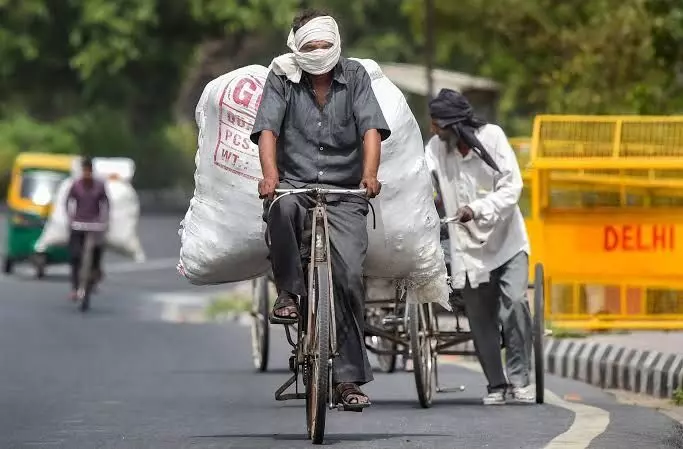Orange alert: Andhra among 3 states witnessing 'dangerously high temperatures'
Heatwave conditions exist when the maximum temperature is over 40°C on the plains, above 37°C on the coast, and above 30°C on the hills, and the departure from normal is between 4.5 and 6.4°C above the usual maximum
By Newsmeter Network
Hyderabad: Weather department issued an orange alert for dangerously high temperatures in West Bengal, Bihar, and Andhra Pradesh.
MeT has warned that heatwave conditions are likely to prevail in parts of Sikkim, Jharkhand, Odisha, and Uttar Pradesh.
MeT said summer would be hotter than usual across the country. However, a western disturbance will bring thunderstorms to Jammu and Kashmir, Himachal Pradesh, and Punjab, according to the India Meteorological Department's forecast.
Monday and Tuesday saw heatwave-like conditions in Punjab and Haryana.
An amber heatwave signal indicates high temperatures with an elevated risk of heat sickness in persons who are either exposed to the sun for an extended amount of time or undertaking heavy activities. The warnings came a day after 13 people died while sitting in the open for many hours at a Maharashtra government function.
During extreme heat, vulnerable persons, such as babies, the elderly, and those suffering from chronic ailments, are more prone to risks. To stay hydrated, IMD recommends drinking plenty of water (even if you're not thirsty), drinking ORS (oral rehydration solutions or electrolyte replenishments), or making comparable homemade beverages.
"When winds blow from the east or the direction of the Bay of Bengal, clouding occurs at times, lowering temperatures over the eastern states. However, hot, dry winds from the northwest are blowing across east India, which has more humidity due to its position. As a result, residents in the eastern states must adopt proper heat avoidance measures," said M Mohapatra, director general of IMD.
Humidity, not temperature, makes the heat wave conditions so extreme, according to Mohapatra. "Even though maximum temperatures in coastal states are similar to those in northern states such as Uttar Pradesh or other parts of northwest India, humidity is relatively high." This is why we're also offering humidity projections for this season," Mohapatra noted.
Humidity hinders people's capacity to cool down since perspiration does not evaporate as rapidly when the air is damp. Such temperatures are frequently referred to as high wet bulb temperatures. IMD does not provide wet bulb temperatures.
"Temperatures in east India are very high, but humidity is still relatively low compared to June and July, and winds are from the northwest. However, the current relative humidity levels might cause discomfort and heat stress. When winds arrive from the east and temperatures are comparable, they can be severe or lethal," said Mahesh Palawat, vice president of climate and meteorology at Skymet Weather.
At 8.30 a.m, the highest temperature in Asansol was 43°C with a relative humidity of 47%; in Angul, the maximum temperature was 43.1°C with a relative humidity of 74%; and in Bolangir, the maximum temperature was 43°C with a relative humidity of 78%. At 8.30 a.m., Kolkata had a maximum temperature of 41.6°C and a relative humidity of 52%.
"These are high humidity levels, but they will have decreased when maximum temperatures are recorded, so they are still bearable," Palawat noted.
Even high-altitude places like Sikkim experienced heat waves.
Heatwave conditions exist when the maximum temperature is over 40°C on the plains, above 37°C on the coast, and above 30°C on the hills, and the departure from normal is between 4.5 and 6.4°C above the usual maximum. A heat wave is called on the second day if these circumstances persist for two consecutive days.
Experts also stated that this year's weather is unfolding in an unexpected manner that has become alarmingly regular. The shifts are abrupt, similar to how they did in 2022 when much of the country bypassed spring and went almost directly from winter to summer.
"There is a clear change in the weather pattern, with snow season extending till the first week of April and then a sudden increase in temperature by mid-April," said Sandeepan Mukherjee, a weather scientist at the GB Pant National Institute of Himalayan Environment and Sustainable Development in Almora, of how the trend has manifested in the Himalayan ranges.
Maximum temperatures in various places in east and northeast India were 3-5 degrees Celsius above average. For the previous six days, heat wave conditions have been observed in scattered areas over Gangetic West Bengal; coastal Andhra Pradesh for four days; and Bihar for three days.
The hottest regions in India in the previous two days were Telangana's Jayashankar Bhupalpalli district (44.6 degrees Celsius), Uttar Pradesh's Sultanpur (43.4 degrees Celsius), and Bihar's Supaul (42.4 degrees Celsius). Prayagraj, Jhansi, Kanpur, and Agra in Uttar Pradesh, Patna and East Champaran in Bihar, and Bathinda in Punjab all saw temperatures exceeding 40 degrees Celsius.